 Image search results - "japansculpture" Image search results - "japansculpture" |
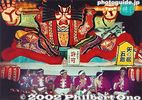
Nebuta are giant, wire-frame, paper lanterns shaped in various legendary and macho characters.The Aomori Nebuta Matsuri is held in Aomori City in Aomori Prefecture during Aug. 2-7. Nebuta are giant, wire-frame, paper lanterns shaped in various legendary and macho characters such as samurai warriors, demons, and gods. They are fantastic works of art dramatically illuminated from the inside. The floats are paraded along the main streets of the city near Aomori Station every night of the festival.
From August 2 to 6, the Nebuta parade is held from 7 p.m. to 9 p.m. On the 2nd and 3rd, the parade is geared for the many children who participate by pulling the floats. About 15 large Nebuta floats and some small Nebuta floats for the children are paraded.
The festival's peak period is from the 4th to the 6th when over 20 large Nebuta floats make their rounds. Be sure to see the festival on one of these three nights.
On the 7th, the last day, the parade is in the afternoon from 1 p.m. to 2:30 p.m. Later in the evening, the Nebuta floats are put on boats to be highlighted by a fireworks display.
The festival is designated by the government as an Important Intangible Folk Culture Asset and not to be missed if you have the chance. It's well worth the trip up north.
|
|
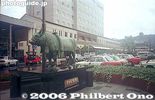
Fighting bull statue in front of Uwajima Station.
|
|
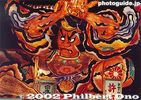
According to one story, the Nebuta has its roots in the 8th century.According to one story, the Nebuta has its roots in the 8th century when there was a rebellion in Ezo (Hokkaido). Ordered by Emperor Kanmu to quell the rebellion, generalissmo Sakanoue no Tamuramaro went to Ezo. However, he failed to capture the elusive chief of Ezo who went into hiding in the mountains.
Sakanoue then set up a trap with large votive lanterns which were lit and accompanied by taiko drums and flutes. This lured the curious Ezo chief out of hiding and led to his capture. The large lanterns were the forerunner of the Nebuta.
|
|

Statue of Takeda Shingen.
|
|

Kakegawa, Shizuoka
|
|

Statue of castle founder and 1st lord, Yuki Hideyasu 結城秀康
|
|

The Peace Statue was built in Aug. 1955, the 10th anniversary of the bombing. The Peace Statue was modeled after popular wrestler Rikidozan.
|
|

Shimizu Bank's relief of Kazutoyo and Chiyo
|
|

Baby Buddha statueLadles are provided for pouring the sweet tea over the Buddha. Sweet tea is also provided to worshippers. It symbolizes the sweet rain that fell when the Buddha was born.
|
|

Kaeru frog to wish you a safe return. 東門院
|
|
|

The Takaoka Daibutsu stands 15.85 meters high, weighing 65 tons. Japan's largest copper statue. Takaoka, Toyama
|
|

Psst, wanna know a secret? Kitain Temple, Kawagoe
|
|

Kannon and bridge, Takasaki, Gunma
|
|

Steel sculpture depicting Ishida Mitsunari giving tea to Toyotomi Hideyoshi. Ishida-cho, Nagahama, Shiga Pref.
|
|

This is a pose when Tora-san goes to the Shibamata Station and he looks back to his sister Sakura who calls him.
|
|

Sculpture in front of Takaoka Station (north side)
|
|
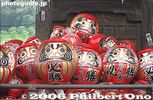
Daruma dolls can never be knocked over since they always stand upright.
|
|
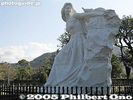
Peace memorial from ChinaThe park also has peace monuments from various countries.
|
|

Sculpture along a shopping street
|
|

This is what you see inside Oku-no-miya Shrine. A giant wooden phallus offering.
|
|

Statue of Chiba-no-suke Tsuneshige and Chiba Castle tower 千葉介常重Lord Chiba-no-suke Tsuneshige was the founder of Chiba Castle in 1126.
|
|
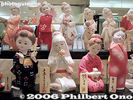
Hakata Ningyo dolls
|
|

Statue of Chiba-no-suke Tsuneshige built in Dec. 2001 to commemorate Chiba city's 80th anniversary. 千葉介常重Lord Chiba-no-suke Tsuneshige was the founder of Chiba Castle in 1126.
|
|
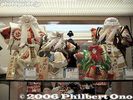
Hakata dolls are Fukuoka's most famous souvenir. There are all kinds and they suit almost any budget.
|
|

Paper plane sculpture
|
|

Another sculpture in the Aviation Memorial Park.
|
|

Daibutsu Buddha statue
|
|

Omi merchant statue.
|
|

Sculpture of Tora-san's famous hat and bag
|
|

Memorial at hypocenterErected in July 1995 for the 50th anniversary.
|
|

Tora-san is helping to install the museum sign.
|
|

Tora-san is helping to install the museum sign. What a great gag. Get you laughing even before you enter.
|
|

Yokozuna statue
|
|

Statue of St. Shinran (1173-1263), founder of the Jodo Shinshu (Pure Land) Buddhist Sect.
|
|

Symbol of Ritto and Ritto Station
|
|

Statue of Emperor Keitai in Asuwayama Park 継体天皇像The 26th Emperor of Japan is said to have hailed from Echizen Province.
|
|

Inuyama International Sightseeing Center "Freude"
|
|

Toyama Castle
|
|
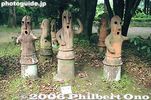
Haniwa statues in Heiwadai Park, Miyazaki
|
|

Shibuya Station, Hachiko statue
|
|

Statue of Omi merchant peddler carrying his trademark "tenbin" pole.
|
|

Sculpture
|
|

Mother and child sculpture
|
|
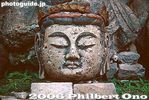
Closeup of Buddha head before reattachment in 1994. Usuki, Oita. 古園石仏
|
|
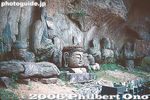
Stone buddhas in Usuki, Oita. 古園石仏
|
|

Popular meeting place at Shibuya Station, south exit.
|
|

Kamaishi Dai-Kannon. She holds a fish.
|
|
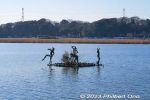
Small sculpture in Lake Teganuma, Abiko, Chiba.
|
|

Statue of Amenomori Hoshu. He is regarded as a pioneer in Korean-Japanese relations and an internationally-minded person ahead of his time.
|
|

19th Century Hall, SL & Piano Museum and sculpture of locomotive wheels.
|
|
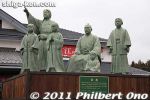
Statue of the Azai family in front of the Azai pavilion. As soon as they arrive here, most visitors take a picture of this sculpture.
|
|

Sculpture of Lady Murasaki Shikibu at Ishiyama-dera, Otsu, Shiga.
|
|

Sculpture of Lady Murasaki Shikibu.
|
|

Bamba Chutaro Jizo-son statue, based on a character in the novel "Mabuta-no-Haha" 瞼の母 by Hasegawa Shin (1884-1963) 長谷川伸. 番場忠太郎
|
|

Statue of Toyotomi Hideyoshi, Nagahama Castle, Shiga. He renamed the town from Imahama to "Nagahama" after his boss and mentor Oda Nobunaga.
|
|
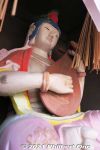
Statue of the goddess Benzaiten at Hogonji, Chikubushima. She plays the biwa lute.
|
|
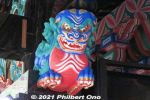
One of the lion dogs on Karamon Gate. Brought back to life from a drab-looking brown. It's part of a wooden protrusion called the "kibana" (木鼻).
|
|
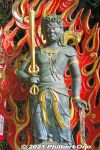
Fudō Myōō (Acala) on Chikubushima. 不動明王
|
|
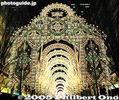
Entrance. The entrance gate is 22 meters tall and 19 meters wide.
|
|

Exterior of Great Buddha, Kamakura
|
|

Great Buddha, Kamakura
|
|

Daibutsu Great Buddha, Kamakura
|
|

Giant loach in front of the hall in Yasugi, Shimane.
|
|

Boy monk with eyeglasses at Eigenji Temple, Shiga.
|
|

While traveling, St. Shinran was unable to cross the Echigawa River since there was a flood. So he stayed at this temple temporarily. During that time, he planted a plum tree which bloom red plum blossoms.
|
|

Statue of Matsuo Basho, haiku poet. Koto-ku, Tokyo
|
|

Statue of Matsuo Basho, haiku poet. Koto-ku, Tokyo
|
|

Statue of Basho sitting at the site of Saito-an house. 採茶庵跡
|
|

Statue of Basho sitting at the site of Saito-an house before departing for the Tohoku region. 採茶庵跡
|
|

Statue of Matsuo Basho.
|
|
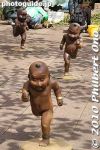
Sculpture in a park in Fuchu, Tokyo.
|
|
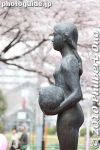
Sculpture in front of Fuchu Pool in Tokyo.
|
|
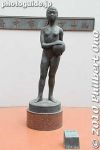
Sculpture in front of Fuchu Pool in Tokyo.
|
|

The famous giant tortoise at Gesshoji Temple, Matsue. They put a stone pillar on its back so it wouldn't walk around at night and wreak havoc. Animal cruelty?
|
|

The famous giant tortoise at Gesshoji Temple, Matsue.
|
|
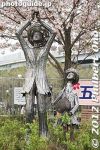
Sculpture of kids catching butterflies along Arakawa River in Adachi, Tokyo.
|
|
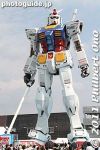
He turns his head back.
|
|
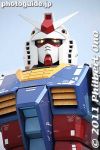
Unfortunately, he couldn't walk or fly.
|
|
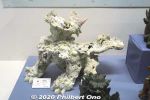
In Okinawa Culture Museum, Shisa made of coral.
|
|
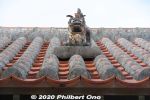
Shisa (シーサー) guardian lion dog statue on the roof to ward off evil spirits at Okinawa World.
|
|

Sculpture by Okamoto Taro at Sukiyabashi near Ginza.
|
|

Handa Dashi Matsuri float in Handa, Aichi.
|
|

Handa Dashi Matsuri float in Handa, Aichi.
|
|

Handa Dashi Matsuri float in Handa, Aichi.
|
|
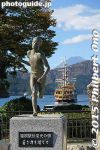
Sculpture of a Hakone Ekiden runner at Hakone-machi Port.
|
|

Statue of Ii Naomasa in front of Hikone Station
|
|

"Boys, Be Ambitious" This famous statue of Dr. William Clark was built in 1976 to mark Dr. Clark's 100th anniversary of his coming to Hokkaido, the 100th anniversary of Hokkaido University's founding, and the USA bicentennial.
|
|

Dr. William S. Clark (1826-1886) was a professor from Massachusetts. The statue was made by a Japanese sculpturer and sponsored by the Sapporo Tourist Association. Hokkaido University has a bust of Dr. Clark which is also popular among tourists.
|
|

Girl and Sheep sculpture at Hitsujigaoka Observation Hill, Sapporo, Hokkaido
|
|

Seated Buddha statue inside Ryotanji's main hall in Iinoya, Hamamatsu.
|
|

Statue of Lord Yamauchi Kazutoyo and Chiyo near Sakata Station in Maibara, Shiga. Unveiled on May 7, 2005. 「なでしこ」山内一豊と千代
|
|
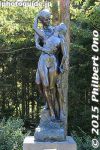
Hakone Open-Air Museum. Well worth a visit. But I wouldn't bring young children. Too many erotic/nude sculptures, mostly female.
|
|
|
|

Hakone Open-Air Museum
|
|

Many Henry Moore sculptures too.
|
|
|
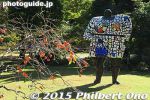
This giant piece is titled, "Miss Black Power" by French artist Niki de Saint Phalle in 1968.
|
|
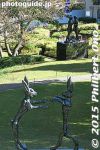
Boxing rabbits
|
|
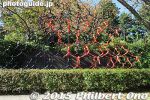
Hakone Open-Air Museum
|
|
|
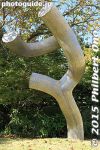
Sturm, Stainless steel piece
|
|
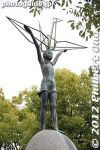
Children's Peace Monument, Hiroshima
|
|
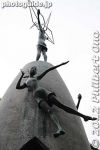
Rear of Children's Peace Monument, Hiroshima.
|
|
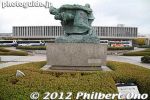
Front of the Hiroshima Peace Memorial Museum (opposite side from the Cenotaph) and Statue of Mother and Child in the Storm.
|
|
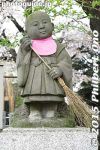
Boy priest sweeping at Ikegami Honmonji, Tokyo.
|
|

Statue of Rikidozan (1924-1963) at his grave at Ikegami Honmonji temple, Tokyo. He was a sumo wrestler until 1950 before becoming a pro wrestler.
|
|
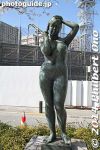
Nude sculpture at Chidorigafuchi Moat, Imperial Palace, Tokyo.
|
|

Statue of Lord Takatora Todo, who became the 11th lord of the castle in 1608. He is revered for revamping the castle and developing the castle town of Tsu. He was originally from Inugami, Shiga Pref. This statue was built in 1998.
|
|
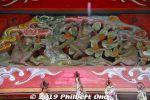
Hanazono Shrine also has a version of the three monkeys here on the Honden shrine hall, but only half the mouth, only one ear, and only one eye are covered as you can see here.
|
|
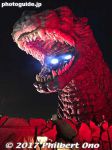
Godzilla's roaring time. On a rooftop in Kabukicho, Shinjuku.
|
|
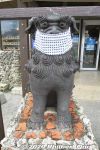
Seesa lion dog with mask, Ishigaki.
|
|

Kishima Shrine has koma-neko cat guardians because silk farmers in the 19th century kept cats to protect their precious silkworms and cocoons from rats. Rats were a major problem for the silk industry.They ate the silk cocoons and worms. So cats saved the local silk industry.
The left cat is the mother (holding a kitten), and right cat is the father. Also respectively "A" and "un."
These koma-neko cat guardian statues were donated in 1832 by silk merchants and wholesalers such as the Tonomura family (外村家一族、岩滝のちりめん問屋、山家屋の小室利七) who were textile merchants from Higashi-Omi (Gokasho), Shiga Prefecture.狛猫
|
|
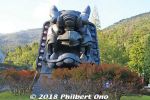
Right outside the oni museum is the world's largest oni-gawara oni roof ornament, 5 meters high, weighing 10 tons. Named "Oeyama Heisei no Dai-Oni." (大江山平成の大鬼).Japanese Oni Exchange Museum in Fukuchiyama, Kyoto Prefecture.
|
|
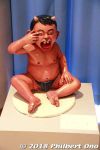
Child demon (バジ鬼) from Bali, Indonesia. Protects children from danger by warning them if they are in danger.Japanese Oni Exchange Museum in Fukuchiyama, Kyoto Prefecture.
|
|
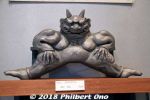
Kawara roof oni ornament.Japanese Oni Exchange Museum in Fukuchiyama, Kyoto Prefecture.
|
|
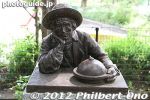
Kodaira Green Road is also noted for sculptures along the way by Kodaira-native Saito Sogan (1889-1974). This is Natural Scientist. 自然科学者
|
|
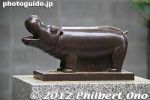
Kodaira Green Road is also noted for sculptures along the way by Kodaira-native Saito Sogan (1889-1974). This is a Hippo. カバ
|
|
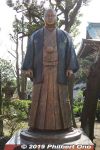
Statue of the late, great Yokozuna Kitanoumi Toshimitsu at Kawasaki Daishi Temple. Erected on the third anniversary of his death by his family. He was only 62. Kitanoumi was one of the greatest yokozuna. 北の湖銅像
|
|
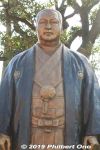
Statue of the late, great Yokozuna Kitanoumi Toshimitsu. I love sumo, but with the premature deaths of great wrestlers like Kitanoumi and Chiyonofuji in recent years, I've been having ambivalent feelings toward sumo because of how it seriously affects the person's health.
|
|

A dinosaur waiting for his train at JR Tsuruga Station. Fukui Prefecture is famous for dinosaur digs. This is just a sculpture stealing a valuable place to sit, but it looks like a kid can sit on his lap.
|
|

Built in 1894 (Meiji 27), the Jizo statue is Japan's largest Jizo statue. 地蔵大銅像
|
|

Statue of Oda Nobunaga at Kiyosu Park, Aichi.
|
|

Statue of Ii Naosuke, lord of Hikone Castle in Shiga Prefecture in Kamonyama Park, Yokohama. He was a key figure in opening Japan to the West. As a result, Yokohama was one of Japan's first ports opened to foreigners.
|
|
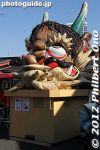
Oni ogre statue used in the Kanda Matsuri.
|
|
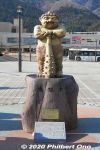
After a 130-min. train ride from Asakusa, Tokyo, we are greeted by this ogre statue at Kinugawa Onsen Station. The Japanese word for "ogre" (oni) is included in the name "Kinugawa." So you'll see lots of ogres (also called demons
|
|
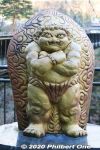
Tateki ogre statue. One of the Seven Ogres of Good Fortune at Kinugawa Onsen. 楯鬼「七福邪鬼めぐり」
|
|

Statue of Yokozuna Tochinishiki (1925-1990) inside JR Koiwa Station. The statue is now a popular meeting place inside the station.
|
|

Statue of Yokozuna Tochinishiki inside JR Koiwa Station. He was the 44th yokozuna and head of the Japan Sumo Association during 1974-1988. The new and current Kokugikan was built under his watch.
|
|

Kobe Port Emigrant Ship Boarding Monument. 神戸港移民船乗船記念碑
|
|

Japanese emigrant family going to South America. "From Kobe to the World"
|
|

Ninja statue in front of JR Koka Station, Shiga Prefecture.
|
|

At Pallet Kumoji mall, there was this Shuri Castle illumination monument complemented by paper lanterns. (首里城うむいの燈(あかり)モニュメント)
|
|
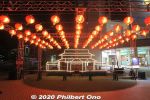
Shuri Castle illumination monument was lit up in the evening until midnight from Oct. 28 to Nov 15, 2020. Many local businesses sponsored the artwork. (首里城うむいの燈(あかり)モニュメント)
|
|
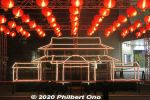
Shuri Castle illumination monument at Pallet Kumoji in Nov. 2020. (首里城うむいの燈(あかり)モニュメント)Lit up in the evening until midnight from Oct. 28 to Nov 15, 2020. Many local businesses sponsored the artwork.
|
|

Shuri Castle illumination monument at Pallet Kumoji in Nov. 2020. (首里城うむいの燈(あかり)モニュメント)
|
|
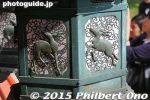
Deer on a bronze lantern atKasuga Taisha Shrine, Nara.
|
|

Statue of Yokozuna Kotozakura, a sumo wrestler from Kurayoshi, Tottori. 横綱琴櫻
|
|

Statue of Yokozuna Kotozakura, a grand champion sumo wrestler from Kurayoshi, Tottori. 横綱琴櫻
|
|

Statue of Yokozuna Kotozakura, a grand champion sumo wrestler from Kurayoshi, Tottori. 横綱琴櫻
|
|

Back view of statue of Yokozuna Kotozakura, a grand champion sumo wrestler from Kurayoshi, Tottori.
|
|
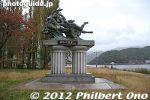
Southern shore of Lake Kawaguchi with a statue of two sister goddesses dancing over the lake. The sculptor was Gakuryo Nasu.
|
|

Shimane Art Museum rabbits
|
|

Jizo statue at Lake Shinji, Matsue.
|
|
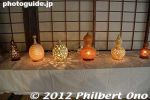
The gourds grown here are used for decorative purposes. Saiko Iyashi-no-Sato Nenba, Lake Saiko, Yamanashi.
|
|
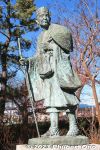
Statue of Matsuo Basho at the southern end of Soka-Matsubara, Saitama. Depicts him looking at his well-wishers in Tokyo (Edo) as he departed for his Oku-no-Hosomichi trip.
|
|

Statue of Mikimoto Kokichi.
|
|

Ama diver sculpture in Pearl Museum, Mikimoto Pearl Island.
|
|

Ama divers at Mikimoto Pearl Museum.
|
|

Liberty Bell, exhibited at the 1939 New York World's Fair. Has 12,250 pearls and 366 diamonds. The crack is reproduced with blue pearls. Mikimoto Pearl Museum
|
|

Yume-dono Pavilion based on the building at Horyuji temple in Nara.
|
|

Mikimoto's Five-Storied Pagoda (御木本五重塔). Exhibited at Sesquicentennial Exposition in Philadelphia, 1926. It has 12,760 pearls.
|
|
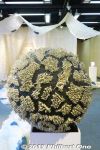
Mino Washi Museum, Gifu
|
|
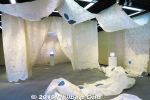
Mino Washi Museum, Gifu
|
|
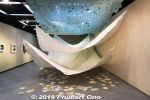
Mino Washi Museum, Gifu
|
|
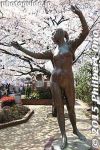
Looks like she's enjoying the cherry blossoms in the nude. Nude sculpture at Harimazaka in spring. Bunkyo Ward, Tokyo
|
|
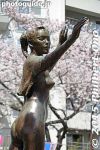
Nude sculpture at Harimazaka in spring. Bunkyo Ward, Tokyo
|
|

Kiyomasa depicted as the rock hauling director. When building the castle, many men had to push and pull large rocks into place. On top of a large boulder, a man would shout and direct the men to move.
|
|
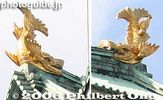
Symbol of Nagoya, golden shachihoko. Killer whale or fish with a tiger's head.First believed to protect the building from disasters, but later served as the symbol of the castle lord's authority. The original pair was destroyed along with the castle tower during WWII, but they were remade in 1959 along with the castle tower. Later, they were recoated with gold. They gleam very well on sunny days. The male fish is on the right (north), and female (south) on the left.
|
|

Statue of Oda Nobunaga at Gifu Station. Personally, I have mixed feelings about revering Nobunaga this much. Yes, he's a major historical figure, but he was also a ruthless warrior who killed a lot of people and caused much mayhem torching temples, etc. Yet he's worshipped like a hero today. A different time, different mindset, and different standard. The dark side of human nature.
|
|

Nobunaga's golden statue at JR Gifu Station.
|
|
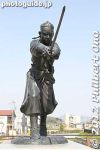
Statue of the Nihonmatsu Shonentai Teenage Corps who fought and died in the Boshin War, in front of Nihonmatsu Station, Fukushima.
|
|
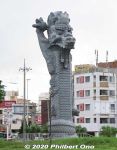
Ryuchu dragon pillar in Naha, Okinawa.
|
|
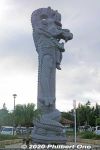
Side view of Ryuchu dragon pillar in Naha, Okinawa.
|
|
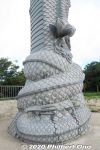
Foot of Ryuchu dragon pillar in Naha, Okinawa.
|
|

Outdoor sculpture
|
|

Nude sculpture, Gaia 大地
|
|
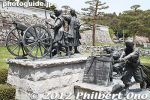
Statue of the Nihonmatsu Shōnentai (二本松少年隊) or the Nihonmatsu Teenage Corps at Nihonmatsu Castle, Fukushima.
|
|
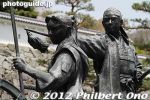
Nihonmatsu Teenage Corps at Nihonmatsu Castle, Fukushima. They were age 12 to 17 who fought and died in the Boshin War.
|
|

In Hakui, Ishikawa, Myojoji Temple's Shaka Nyorai Buddha statue (釈迦如来立像) standing 5 meters high inside Jorokudo (Shakado) Hall. 丈六堂(釈迦堂)Website: http://myojoji-noto.jp/
|
|

Statue of Nakae Toju expressing filial piety for his mother. In front of Toju-no-Sato Adogawa.
|
|
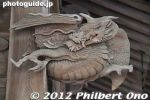
Dragon carvings at Tanashi Shrine. By coincidence, I visited in the year of the dragon, 2012. Nishi-Tokyo, Tokyo.
|
|
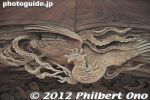
Phoenix wood carving at Tanashi Shrine in Nishi-Tokyo, Tokyo.
|
|
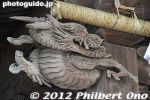
Dragon wood carving at Tanashi Shrine. By coincidence, I visited in the year of the dragon, 2012. Nishi-Tokyo, Tokyo.
|
|

Odori Park's most photographed sculpture shows three ballerinas near a water fountain. Sapporo, Hokkaido
|
|
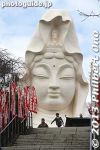
Again, it's amazing how they placed the statue here. Another prime vantage point.
|
|
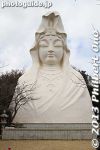
Ofuna Kannon temple's giant, white Kannon statue. For a long time, since I only saw the head sticking out of the hill, I assumed that it was a reclining buddha.
|
|
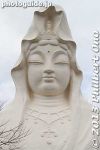
Closeup of Ofuna Kannon temple's giant, white Kannon statue.
|
|

Statue of Lord Toda Ujikane who was the Ogaki Castle lord in 1635.
|
|
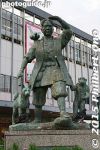
Statue of Momotaro Peach Boy in front of JR Okayama Station's east side.
|
|

Lake Toya is decorated with almost 60 outdoor sculptures along the shore all around the lake. This is the first one you will likely see. By Tando Saka. 坂 担道「湖渡る風」
|
|

Statue of an ama woman diver sitting on a rock on the Onjuku Station train platform. These women dived deep in the ocean (without scuba gear) from small boats to harvest shellfish and other seafood.
|
|

Onna (Woman) by Chizuko Sasado. 笹戸 千津子「女」
|
|

A prince and princess on camels. This monument was built in 1969. 月の沙漠
|
|

Sculpture: Anthem of the Sun, by Machiko Kodera 小寺 真知子「太陽の賛歌」
|
|

Sculpture: Anthem of the Sun, by Machiko Kodera. Lake Toya has many nude woman sculptures.
|
|

Sculpture: by Keiko Amamiya, 雨宮 敬子「洞照」. One problem with the outdoor sculptures, especially human figures, are the birds. Their droppings create unsightly white streaks down the body.
|
|

Sculpture: At the Lake, by Akihiko Kurokawa 黒川 晃彦「湖畔にて」
|
|

On the west end of Toyako Onsen are more sculptures and a park. Sculpture by Kan Yasuda. 安田 侃「意心帰」
|
|

Sculpture: Light of the Moon, by Igor Mitoraj. イゴール・ミトライ「月の光」
|
|

Taiko drummer sculpture at Ogoto Onsen Station.
|
|

I was impressed with Seian University's slogan of being an ”Art Museum on Campus.” These colorful men are gazing at Lake Biwa.
|
|

This is a statue of Yamato Takeru (日本武尊) at Otori Taisha. He went around Japan and defeated his enemies until he finally met his demise on Mt. Ibuki in Shiga Prefecture where sought to kill an evil god. This god disguised himself as a white boar (another version says it was a serpent) who sprayed a poisonous mist that sickened Yamato Takeru.
He eventually died and when his body was cremated and buried in Kameyama in Mie Prefecture, his spirit rose from the ashes as a great white bird. This bird landed in a few places before finally landing here in Sakai, Osaka, where this Otori Shrine was built. "Otori" means "Big Bird" (not like Sesame Street, but more like a great swan or firebird).
|
|
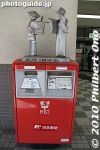
Folk dancer sculpture on mail box at Mishima Station.
|
|

Statue of Lord Date Masamune at Sendai Castle's Honmaru. One of the most popular and famous samurai of all time.
|
|

If you look closely, you can that see one of his eyes is blind.
|
|
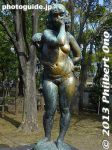
Sendaibori, Koto-ku, Tokyo. Mother and child statue.
|
|
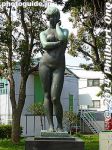
Sculpure at Sendaibori Park, Koto-ku. Tokyo
|
|

By now, you will notice that the tanuki (racoon dog) is the symbol of Shigaraki. This giant tanuki greets you at Shigaraki Station. Wish they removed that pay phone.
|
|

Giant tanuki at Shigaraki Station. Wish they removed that pay phone.
|
|

The boar's mane is made of tiny fish. You can smell the seafood. I'm surprised that crows never swooped down on the floats to feast on them.
|
|

This design won 3rd place. White sugar is one of the ingredients.
|
|

Life-like boar, all edible materials.
|
|

Near Kokusai-dori (Naha's main drag) at Pallet Kumoji mall, there was this Shuri Castle illumination monument complemented by paper lanterns. (首里城うむいの燈(あかり)モニュメント)
|
|
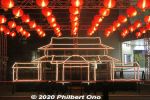
Shuri Castle illumination monument was lit up in the evening until midnight from Oct. 28 to Nov 15, 2020. Many local businesses sponsored the artwork. (首里城うむいの燈(あかり)モニュメント)
|
|

The golden sculpture is atop the Asahi Beer building in Asakusa. It's supposed to be beer froth, but most people think it looks like doo-doo.
|
|
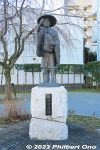
Statue of Kawai Sora, Matsuo Basho's apprentice and travel companion for Oku-no-Hosomichi. This statue is at the intersection leading to the old Nikko Kaido Road. It's across the bridge from the Basho statue at the watchtower.
|
|

Catfish sculpture on a small office building in Soka, Saitama.
|
|
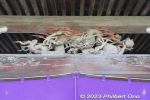
Tofukuji Temple in Soka, Saitama.
|
|

Statue of Yajirobe'e ("Yaji") on the left and Kitahachi ("Kita") from the story "Tokaido-chu Hizakurige" by Juppensha Ikku (1765-1839) a comic playwright who was born in Shizuoka city.
|
|

Yaji in front of Sumpu Castle in Shizuoka city. 「東海道中膝栗毛」十返捨一九
|
|

Kita in front of Sumpu Castle in Shizuoka city. 「東海道中膝栗毛」十返捨一九
|
|
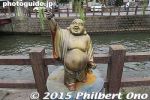
Ono River has these little statues of the Gods of Good Fortune. Sawara, Katori, Chiba.
|
|

Maeda Toshinaga, the 2nd lord of the Kaga domain and founder of Takaoka
|
|

Benzaiten, goddess of music and anything that flows. Tarobogu Shrine, Higashi-Omi, Shiga.
|
|

Near the main gate of the University of Tokyo’s Faculty of Agriculture is the statue of Hachiko reunited with its master.
|
|
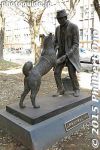
Hachiko's master Professor Ueno died during a lecture on campus in 1925.
|
|
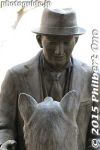
Smiling professor.
|
|

Originally, there were 48 stone buddhas. Only 33 remain now. Thirteen of them were moved to Sakamoto in Otsu, and 2 were stolen. Although they stand upright, it's possible that they can fall on you, especially if you've been bad.
|
|

The stone buddhas are about 1.6 meter tall, made of granite.
|
|
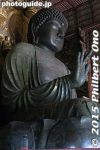
Great Buddha, Todaiji Temple, Nara
|
|
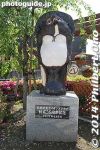
Tanuki in Tatebayashi, Gunma.
|
|

This sand sculpture's theme was "Hollywood" in the 1950s-60s. John Wayne, Laurel and Hardy, Lucille Ball (I think). Tottori Sand Museum in 2017.
|
|

Closeup of Marilyn Monroe in sand. That's her dress in "The Seven Year Itch." Tottori Sand Museum.
|
|

Tennis player sand sculpture.
|
|
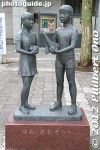
Statue in front of Chiaki Mukai Children's Science Museum, Tatebayashi, Gunma. The boy holds a space shuttle.
|
|

President Theodore Roosevelt sand sculpture. Mr. Rough Rider himself. Look at how detailed it is. Notice the veins on his hand.
|
|

"Washington Crossing the Delaware" sand sculpture in Tottori, Japan.
|
|

George Washington was in two sculptures.
|
|

Hawaiian hula sand sculpture in Tottori.
|
|

President Donald Trump as a sand sculpture in Tottori, Japan.
|
|
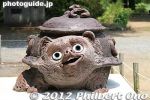
A few statues shows a tanuki morphed into a steel tea pot at Morinji temple, Tatebayashi, Gunma Prefecture. Based on the Bunbuku Chagama folktale.
|
|
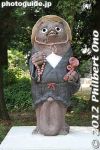
Tanuki raccoon dog statue at Morinji temple at Tatebayashi, Gunma Prefecture.
|
|
|
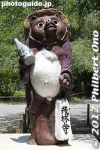
4. The large belly is for being calm as well as bold...
|
|

Tanuki raccoon dog statue at Morinji temple at Tatebayashi, Gunma Prefecture.
|
|
|
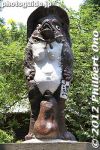
A giant Tanuki raccoon dog statue at Morinji temple at Tatebayashi, Gunma Prefecture. Donated by Tobu Railway in 1960.
|
|

Sagimai statue in Tsuwano, Shimane.
|
|

White stork mail box at Oriental White Stork Park in Toyooka, Hyogo.
|
|

On Caban Street, this drink vending machine designed like a bag. Toyooka, Hyogo.
|
|

Statue of a Japanese archer at Yaai Shrine, Toragozen-yama, Torahime, Shiga.
|
|
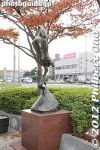
Sclupture along the main drag of Ube-Shinkawa, Yamaguchi.
|
|

Sclupture along the main drag of Ube-Shinkawa, Yamaguchi
|
|
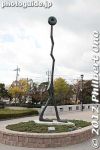
Ube-Shinkawa, Yamaguchi
|
|
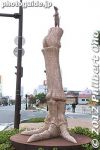
Dinosaur leg, Ube-Shinkawa, Yamaguchi
|
|
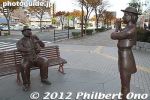
Ube-Shinkawa, Yamaguchi
|
|

Although there is cormorant fishing in other parts of Japan, Gifu's Nagara River ukai cormorant fishing is most famous because it is connected to the Imperial family. Statue of a ukai cormorant fishing master called an "usho." 鵜匠の像
|
|
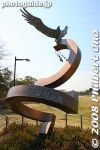
Wakasu Park, Tokyo.
|
|
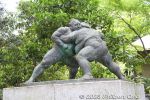
Statue of sumo wrestlers at the entrance of Yasukuni Shrine's sumo arena. The shrine has a large outdoor sumo arena with a capacity of 6,000.
|
|

Grapes to sit on. Kajo Central lobby, Yamagata.
|
|
|
|